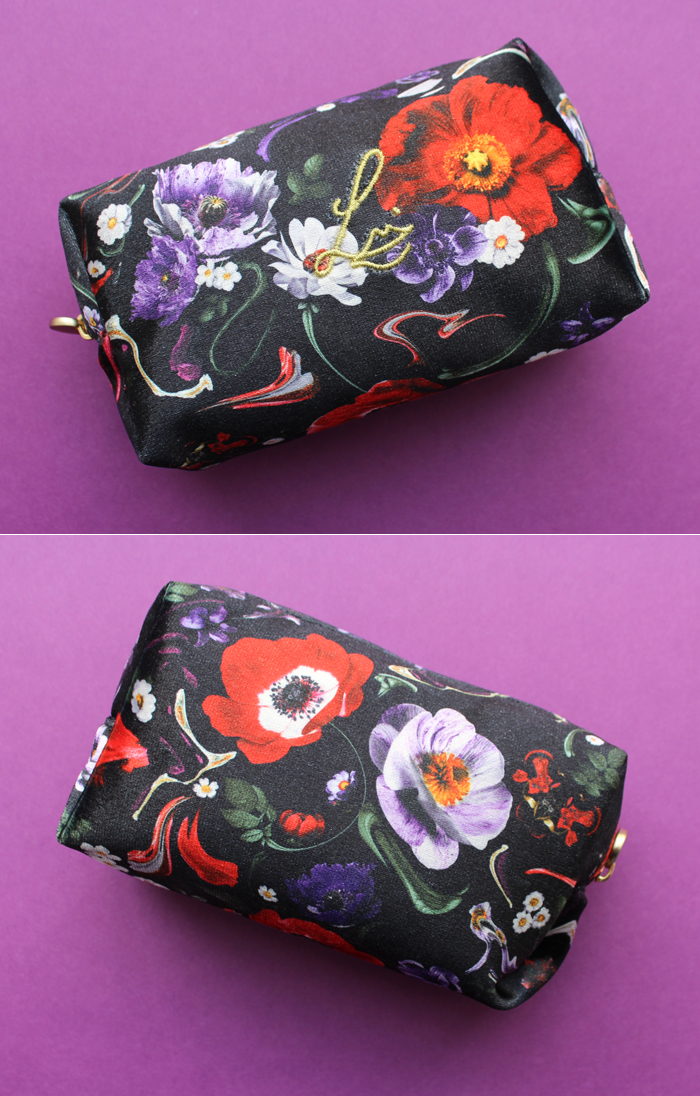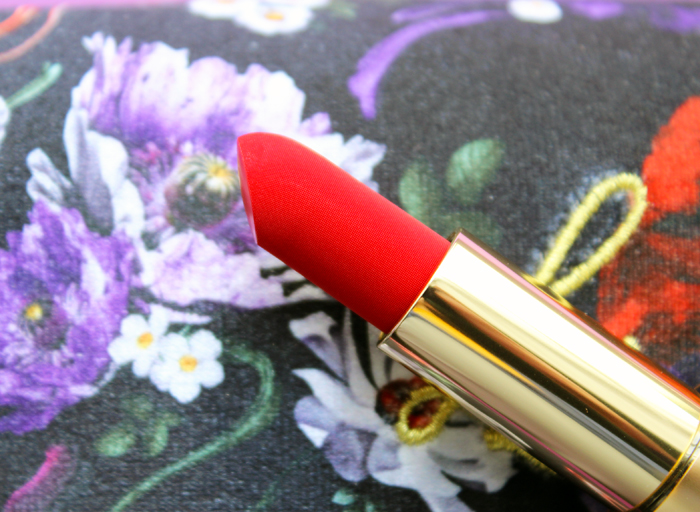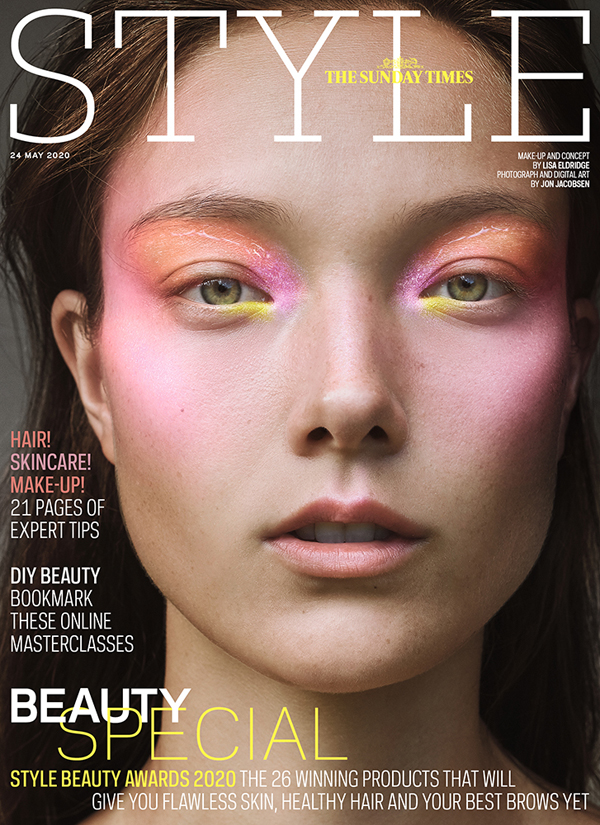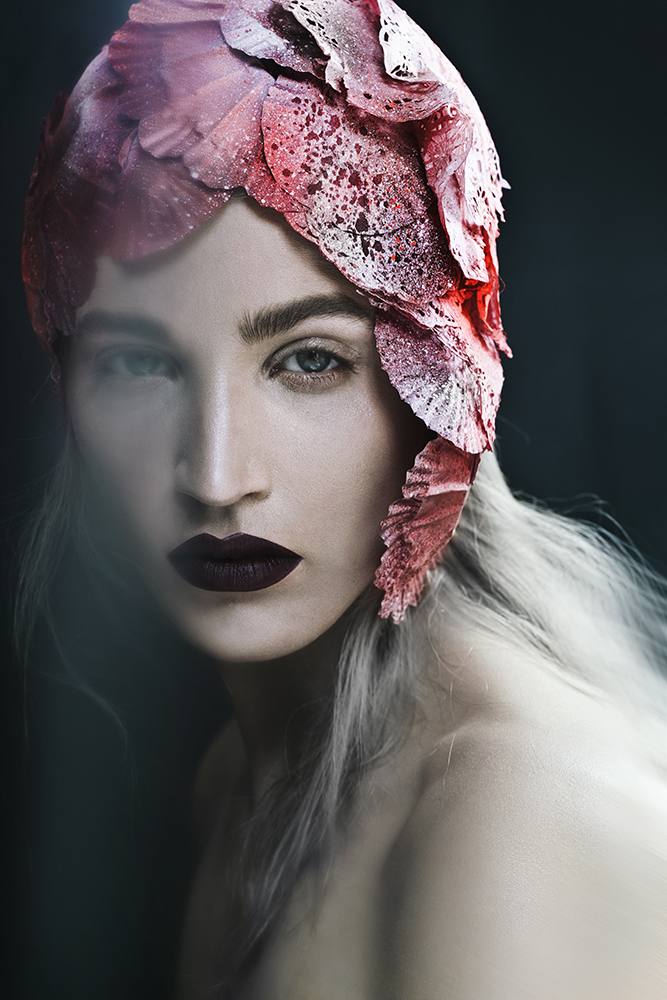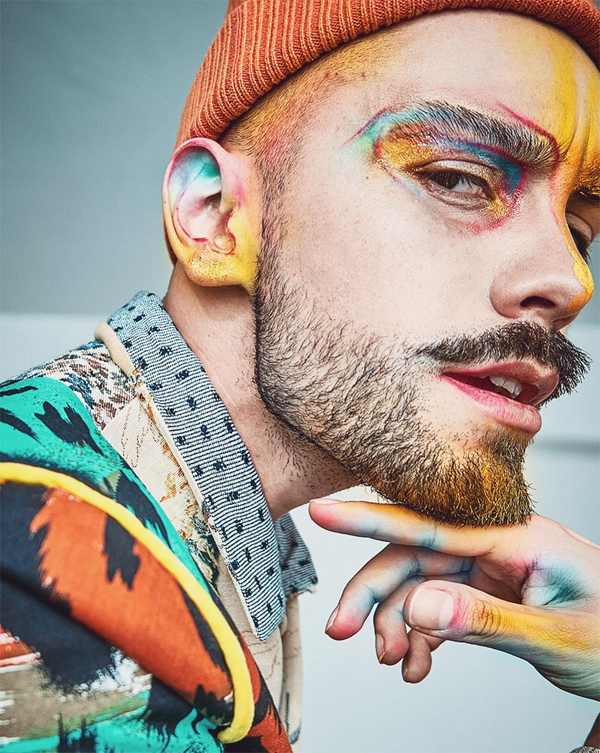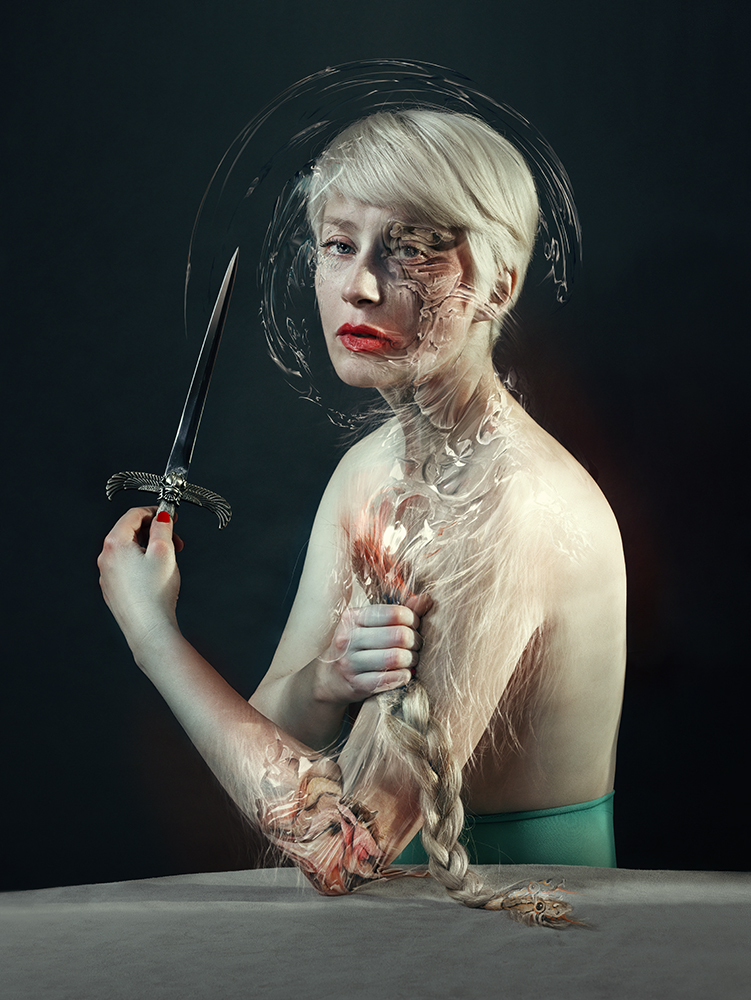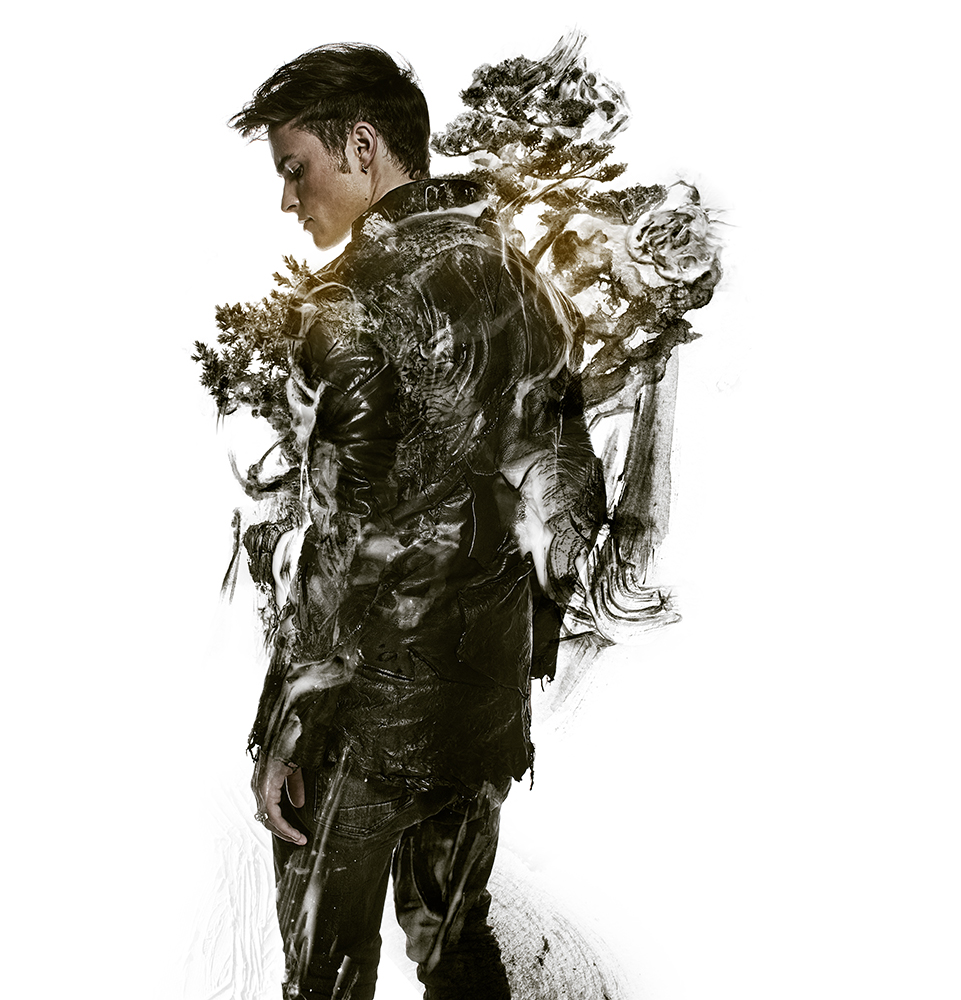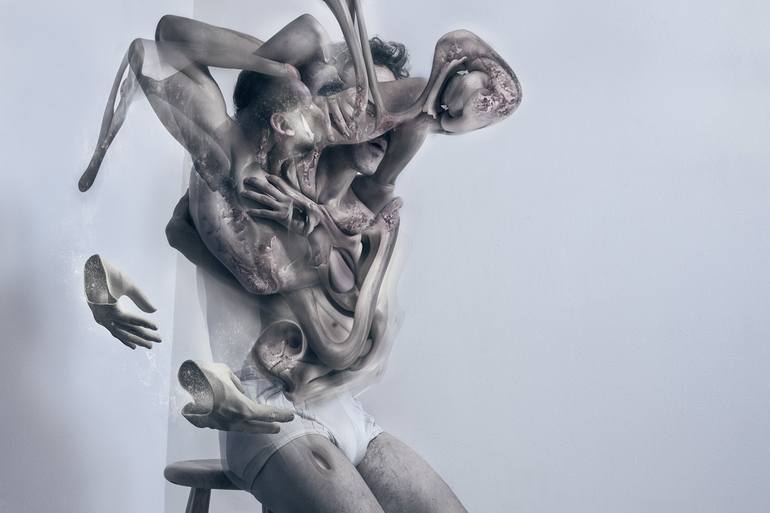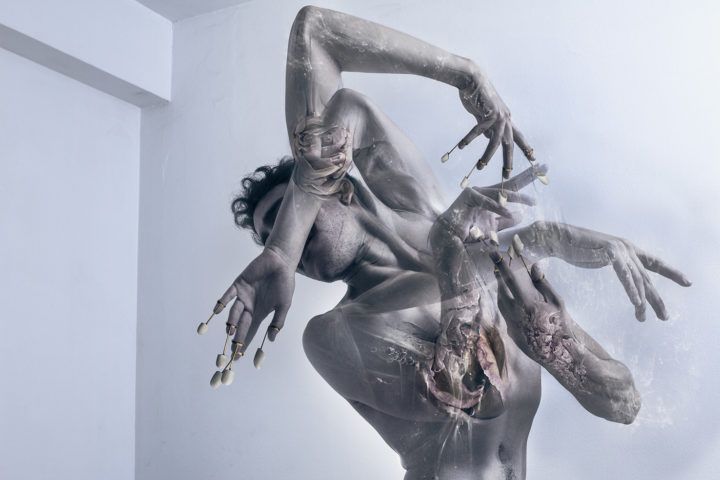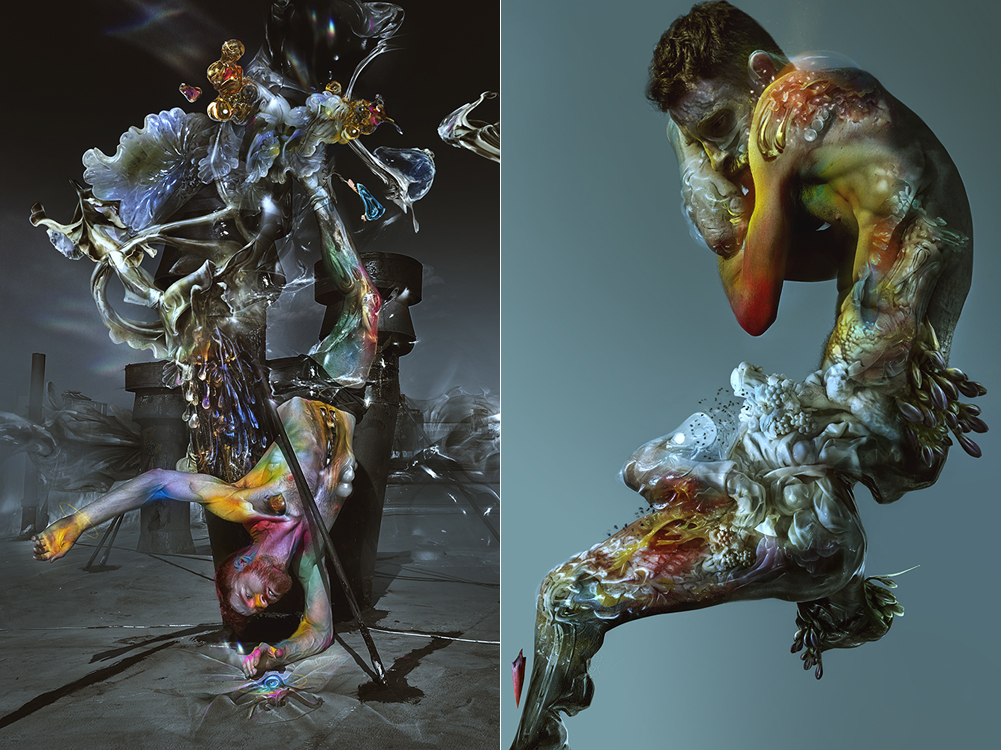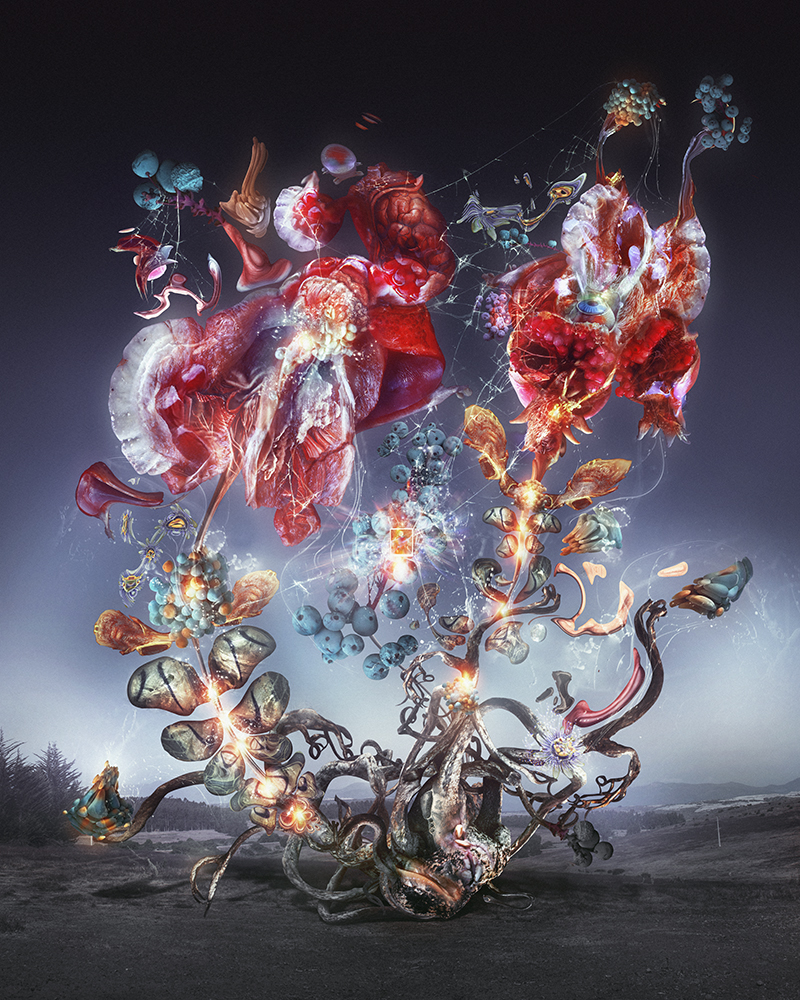“My work always aims to grow through an honest contact with people. I love feeling emotions and being able to create something that can touch people’s hearts. My work is about the symbolic things we put into our daily lives, and I’m always curious to see how everyone sees the world. As I mentioned before, I see art as a parallel, innocent language that leads me to different opportunities and challenges to keep growing as a person.” – Jon Jacobsen
Last fall, I remember being very excited to see the launch of a set of Lisa Eldridge lip products in a beautiful velvet pouch. When I saw that the pouch was the work of multimedia artist Jon Jacobsen I knew I had to have it for the Museum. In case you need a refresher, Lisa Eldridge is one of the top makeup artists in the world and launched her own line in 2018. She is also a makeup historian, having written the excellent Face Paint, and she also possesses what is widely considered to be the best collection of vintage makeup in the world. I can only dream that the Museum’s collection will compare to hers someday!
As for Jon Jacobsen, he is a 32 year old Chile-born, Portugal-based photographer, filmmaker and all-around master of digital art. He designed the gorgeous floral pattern for the pouch. The rich shades of the flowers against a black background are dramatic and moody, perfect for a fall release.
The bag is obviously velvet to coordinate with Eldridge’s splendid Velvet lipstick line. Look at that texture! I’m still flabbergasted every time I see it. (And I really need to order some of these to actually use.)
The partnership is not a surprise. I’m guessing it came about as a result of the pair having worked previously on the Sunday Times’ Style beauty feature back in May of 2020. As the world was in lockdown, makeup artists, fashion designers and photographers found themselves unable to work in the flesh, thereby forcing their processes to go virtual. (See also Harris Reed’s 2020 graduate collection.) While “digital makeup” is not new, the pandemic forced a higher level of creativity.
Jacobsen was a natural choice to handle the project, given his unique approach to digital art. (And no, digital art is not just making silly filters for social media apps.) For Jacobsen, digitally altering images isn’t about simply enhancing what’s already there but adding an element of fantasy to produce surreal effects that challenge viewers’ perception of the physical realm. In the case of the Sunday Times feature, Jacobsen deftly “applied” makeup designs created by Lisa Eldridge onto their model’s face. The resemblance to real makeup is shocking. When combined, Eldridge’s and Jacobsen’s techniques yield an incredibly true-to-life effect that is nearly indistinguishable from physically applied makeup, yet still appears magical.
In an Instagram post, Jacobsen explained the role of each artist working on the feature. “The process behind each look was very unique and fascinating: With Lisa Eldridge in London, our lovely model Yumi Lambert in Maui and myself in Porto, we had to come up with an idea to bring all places together having technology on our side. With this in mind, Lisa designed and applied a variety of textures and colours onto her own skin which I later ‘brushed’, twisted and blended using a variety of digital techniques over the portraits that Yumi provided from a shoot that I directed from home. This was new territory for all of us – including for our lovely editors who trusted in us 100% (thank you) – so for several days Lisa and I connected over zoom meetings, experimenting and finding the right harmony, light and combination of textures to achieve something realistic with a hint of fantasy. This was a very meticulous process and I enjoyed every second of it! I might be quiet about this but I do love make up, not only from the fact that you can build endless characters and emotions, but also from how its composition changes through history.” Every single texture and placement – from individual blush powder particles, the sheen of gloss with color concentrated in the center of the lips and shimmery eyeshadows in variety of shades – perfectly mimic makeup applied in the flesh. As Jacobsen notes, “real textures [were] translated to pixels.”

His appreciation for makeup is abundantly clear, most likely stemming from his interest in the concept of transformation and questioning the boundaries of the human body, along with his passion for portrait and still life genres. All of these themes are inseparable from makeup. “Beauty shoots are definitely my favourite ones, it literally feels like eating dessert. My team and I always shoot knowing that I might add something on post-edition. Once the photos are taken, I lock myself in the studio to analyse the images and find the right universe of shapes. This a very experimental part of the process that I enjoy doing alone. There I imagine myself as a scientist, a musician, or a cook trying to find the right flavour, the right sound – it’s hard to explain, but it is a blissful moment. Once they are done, I share it with my team and we celebrate…creating feels like making a puzzle that has no shape, but with the help of instinct, a good team and honesty, I can sense once it’s finished.”
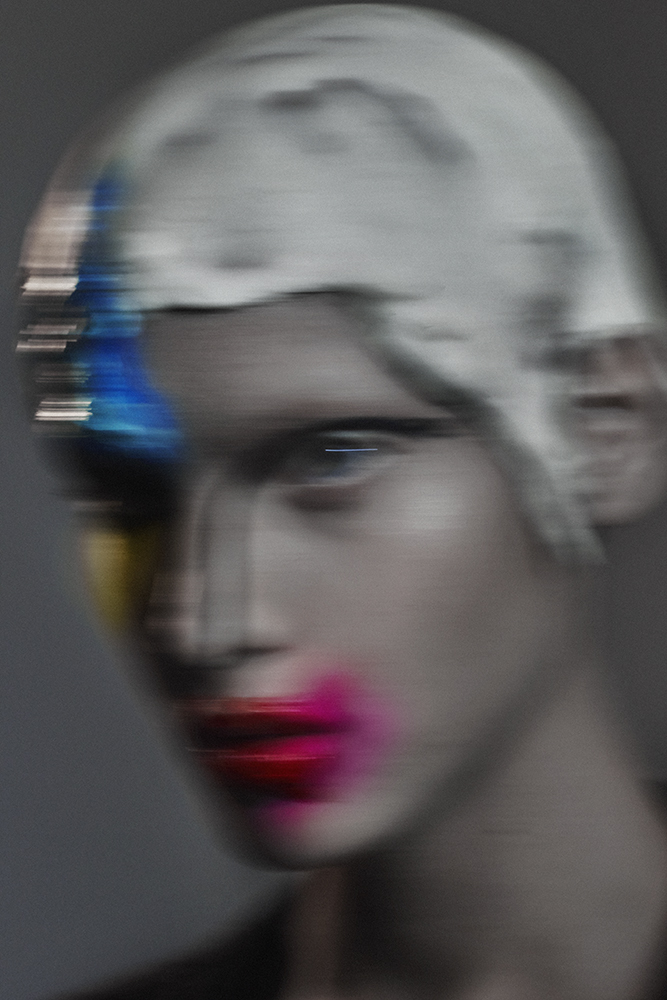
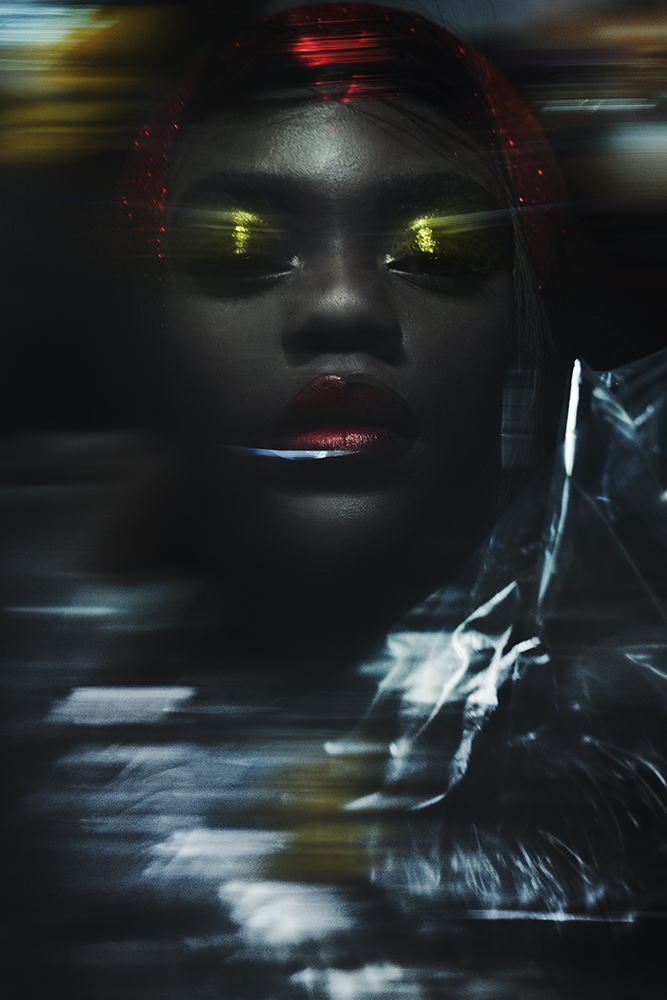
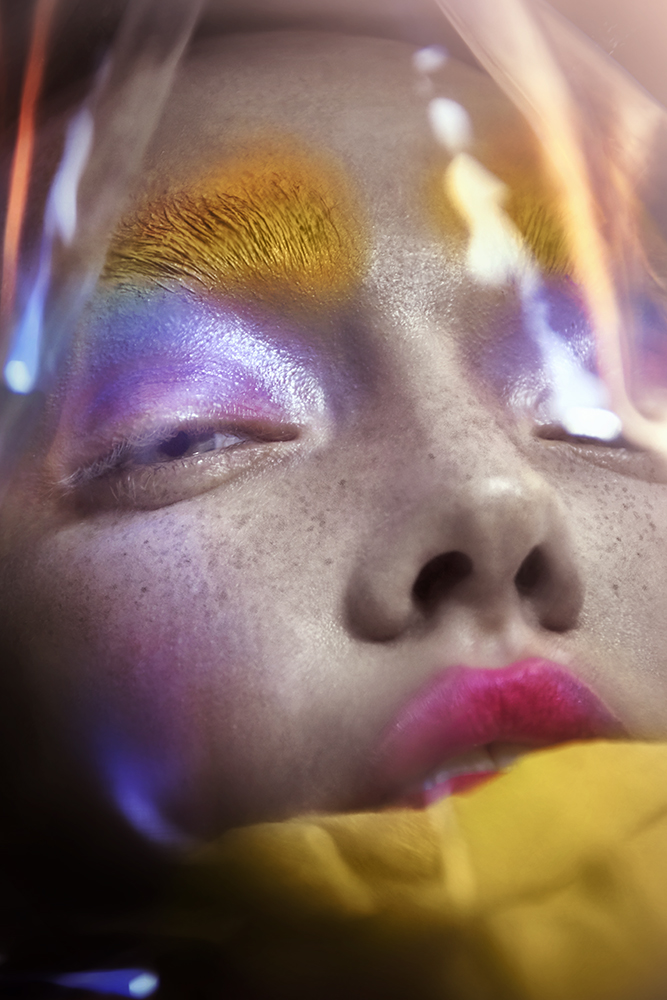
His photos are even more impressive when you discover that Jacobsen is entirely self-taught, citing the Internet as his primary teacher. At the age of 15 he took his first photo. After graduating college with a degree in graphic design, Jacobsen vowed to pursue art full-time. In an interview with Retouching Academy, he describes his journey to becoming an artist. “I started creating images at the age of 15, experimenting with any kind of camera that I could borrow. At that time technology was slowly becoming more accessible and I was curious to know how far I could get with it. I became obsessed with the idea that I was able to create infinite, surreal artworks from the comfort of my own room. My artistic journey began when my art teacher from school, Andrea Reyes, saw some of the images I had posted on social media. She pushed me to keep honing my skills by assigning me extracurricular activities such as additional homework, PowerPoint presentations and giving me quick art history classes during the school breaks. This was a key moment in my development as an artist as it was my first professional encounter with Art. I slowly became obsessed with creating visual metaphors with my images. The Internet also played a very important role in my development as an artist: It was (and still is) my main school. I watch tutorials every day and learn more and more about art. I keep sharing my work on social media, such as Instagram and Facebook, to maintain a close relationship with my audience and to learn from other talents. It wasn’t until I moved to Santiago (at the age of 21) when I decided to turn this ‘hobby’ into a full-time job. I graduated from university as a graphic designer but decided to present myself as an Image-maker, in order to be more flexible and work in all my fields of my interest: from being an artist who exhibits his work, to creating fashion editorials and films for magazines, and working as a high-end retoucher.I became interested in mixed media as a way to find an organic result through digital art. I am constantly creating textures, collecting images from my daily life and working with different kinds of materials depending on the requirements of each artwork…Last but not least, being able to sustain myself by doing this job feels like a big achievement. I come from a middle-low class family, with no art background. Choosing a life as an artist was a huge decision which I don’t regret. It has opened many doors and presented me with great opportunities so far.”
Much of his oeuvre entails futuristic visions of the human body that combine realism with fantasy elements. The artist has been fascinated by photography’s creative potential since childhood. “Since I was a kid I always wanted to add an extra layer of fantasy to things, and photography wasn’t an exception,” he says in an interview. “I loved the idea of bringing something I registered to a computer, a flower for example, and twist it enough to create a completely different result. As much as I appreciate photography as the closest way to capture reality, I find there are many voids to be filled, especially in terms of the emotional aspects. Conventional photography registers light and shows a result based on the norms behind the human eye, but what about the emotions myself and my subject feel at that moment? How can these be shown? Digital art brings endless questions, and I get obsessed with the vast amount of answers I can find. There, I found a space of free will that I can link with my daily life, connecting the real with fantasy.”
He often works with other artists from a variety of fields for his projects, citing the importance of familiarity with other disciplines for one’s own artistic practice. “Working on digital is really fun because it’s pretty versatile, but it can also be daunting when you’re spending days in front of a screen. As a digital artist I crave for tangibility and the desire to use my hands/body to explore other media to keep evolving as an artist. Even if your plan is not becoming a sculptor, try doing it at least once and see what happens, or try out a new cooking recipe… a little bit of the unknown is enough to find a HUGE amount of answers. That’s how I got into dancing, swimming, contemporary jewelry and music. Even if I’m not an expert in those disciplines, I learn a lot and include this new knowledge into my creative process, for example, while tracing the composition before starting a piece, or by creating models/small sculptures, textures and volumes to be used in future projects. Exploring new media also expands your knowledge and brings new contacts to your life: Win-win situation!”
Indeed, Jacobsen’s endeavors are amplified through collaboration. For 2015’s “Ínsula”, for example, he worked with Columbian sculptor Daniel Ramos Obgregón and dancer José Tomás Torres. Jacobsen photographed Torres in different stances and sent the images to Obgregón, who supplied photos of his surreal series of ceramic body accessories and prosthetics. Jacobsen edited the images so that the ceramic pieces became technological-based appendages rather than human. Digitally slicing the dancer’s body to reveal veins coursing with electric currents and smoke-like swirls in place of blood and muscle, Jacobsen presents his vision of the digital age’s impact on human evolution. The official project description: “The digital era is no longer the futuristic set of a sci-movie. It has become our present reality where all digital platforms, computers, mobile phones, and tablets are now prosthetic elements of our daily lives, which work as extensions of our bodies and minds. We invest so much of our time into these objects that we have started to detach from our physical bodies making us now mind-based digital beings – androids in the becoming. Internet and social networks have created a complex social fabric where it is possible, through avatars and alter egos, to interact with the rest of the world – erasing any geographic border that might exist. By questioning this reality and how it affects our body limits ‘Ínsula’ starts as an observation of this behaviors to explore and interpret the evolution from a human into a digital Homo Sapiens.”
While the distorted, grey-skinned figure appears grotesque, Jacobsen maintains his conception of virtual humanity is not dystopian; he’s merely exploring what our digital selves might look like. The lack of normal human skin tone and organs expresses Jacobsen’s notion of our online bodies. “I call it a projection, what we do on Facebook or Instagram, or the Internet in general. A part of ourselves is not physical anymore,” he tells Wired. For Jacobsen, the digitization of the human body, with a smartphone as an additional appendage of sorts, means having access to unlimited knowledge that wasn’t as readily available to previous generations. “You also have your phone attached to your body all day. It can become a vessel of eternal knowledge if you use it wisely. It makes me happy to observe these new generations having technology so intrinsic to their bodies. They grow up playing with apps since day zero and there is so much to reinvent.” I can’t say I fully agree; while I acknowledge the Internet provides a tremendous wealth of information and allows me to connect with people I otherwise would never “meet”, I resent being tethered to my phone 24/7 (which, by the way, I refer to as the “nightmare rectangle”.) I certainly would never want it to physically take over any part of me. Jacobsen’s vision may not be dystopian, but for older generations it certainly can be interpreted as unsettling.
Still, the animation makes a huge difference – the images become less sinister when viewed as fluid motions. Additionally, “Ínsula” is notable in that it was created with the artists situated in different countries. Nowadays that’s not surprising, but 5 years before the pandemic necessitated remote work, it seems even more ahead of its time.
Similar ideas are explored in “The Great Barrier”, a 2018 series of photos that simultaneously recalls the beauty and destruction of Australia’s Great Barrier Reef. The centering of a human body – this time fused with marine flora and fauna instead of tech gadgets and electrical signals – depicts “an abstract vessel interacting with the environment,” mirroring either the vibrancy or decay of its surroundings and perhaps serving as a commentary on humanity’s role in saving or destroying the planet. “The Great Barrier” was also the result of a remote collaboration between Jacobsen and Australian performer/movement director Paul Zivkovich.
In my opinion, Jacobsen’s most refined examination of the body and its boundaries is “Digital Flesh”, which incorporates the style and subjects (flowers, fruit, etc.) found in traditional still life painting and combines them with tendons, muscles and internal organs. “These still lifes focus in finding human shapes in the everyday objects, for they carry the symbolic meaning through our senses and time. Either in their natural state or digitally manipulated selves, these forms float in harmony,” notes the project description.
The one titled “Uncertainty” is my favorite of the series, as there’s something vaguely aquatic about it. The large pink flower towards the left seems to be emanating light, illuminating its surroundings like a bioluminescent creature of the deep ocean.
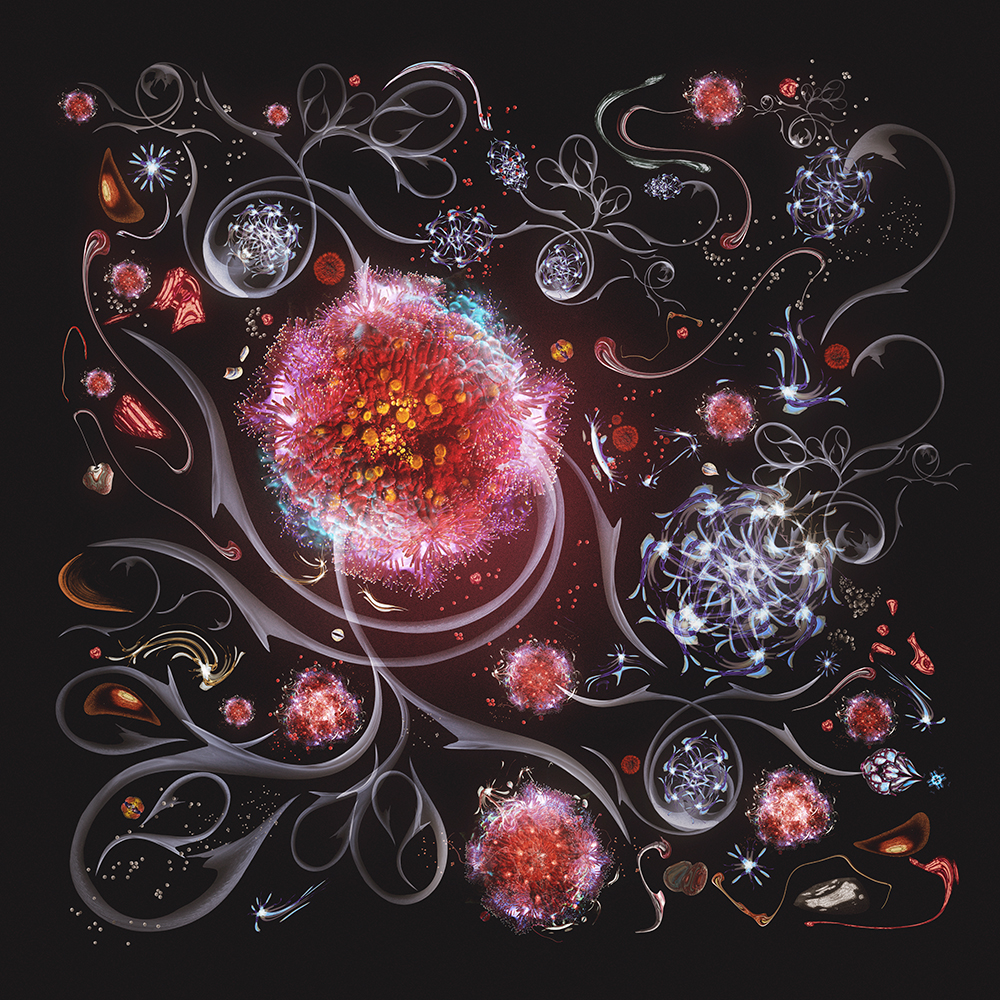
(all images of the artist’s work via jon-jacobsen.com)
I also like “Digital Flesh” because it’s the most stylistically similar of Jacobsen’s works to the Floral Fantasy pouch. The artist created a short video that alludes to makeup’s tactile properties. The flowers appear to represent makeup colors and the pollen is reminiscent of delicate powder particles.
Lisa Eldridge – Floral Fantasy x Jon Jacobsen from Jon Jacobsen on Vimeo.
Overall, I enjoyed this collaboration. I do think Jacobsen tamped down the weirdness too much; I would have liked to see something more surreal or at least something that spoke more literally to the theme of evolution as in his 2017 film Die Verwandlung (“The Metamorphosis”, based on Kafka’s work), since makeup can be such a powerful agent of transformation. And while I enjoyed the video he created for the collection, it may have been interesting to do a makeup version of “Ínsula” or “Digital Flesh” since the same themes apply to makeup, i.e. showing how cosmetics can become one with, or an extension of, the human body. (Think about all the tips for “melding” a product with the skin rather than having it sit on top of it.) Alas, something really bizarre probably would not have been as marketable. Of course, for me, the stranger the better!
What do you think about Jacobsen’s work and the design he made for Lisa Eldridge?


